![]()
![]()
![]()
Use LEFT and RIGHT arrow keys to navigate between flashcards;
Use UP and DOWN arrow keys to flip the card;
H to show hint;
A reads text to speech;
159 Cards in this Set
- Front
- Back
- 3rd side (hint)
|
Nucleus in the hypothalamus charge of saciety center |
Ventromedial Nucleus |
|
|
|
Nucleus in the hypothalamus in charge of Hunger and angry center |
Lateral Nucleus |
|
|
|
Nucleus in the hypothalamus in charge of cooling and parasympathetic |
Anterior Nucleus |
|
|
|
Nucleus in the hypothalamus in charge of Heating and sympathetic |
Posterior Nucleus |
|
|
|
Nucleus in the hypothalamus in charge of Circadian rhythm and works in conjunction with the pineal gland |
Suprachiasmatic Nucleus |
|
|
|
Nucleus in the hypothalamus in charge of synthesize ADH |
Supraoptic Nucleus |
|
|
|
Nucleus in the hypothalamus in charge of synthesize Oxytocin |
Paraventricular Nucleus |
|
|
|
Nucleus in the hypothalamus in charge of sexual behavior and release GnRH |
Preoptic Nucleus |
|
|
|
An injury in the lateral Nucleus of the hypothalamus will make you do what? |
Stop eating, will never get hungry. |
|
|
|
An injury in the ventromedial Nucleus of the hypothalamus will make you do what? |
Eternal Hunger, hyperphagia, weight gain |
|
|
|
Explain the mechanisms of fever and the thermoregulation. |
Fever is triggered by pyrogens and inflammatory proteins Il-1, Il-6, and TNF. Stimulated by prostaglandin E2. This increases the anterior hypothalamus set point causing hyperpyrexia. |
|
|
|
All sensory information goes through the thalamus except? |
Smell |
|
|
|
What are the 6 most important thalamic nuclei |
Ventral posterolateral (VPL) Ventral posteromedial (VPM) Lateral geniculate Nucleus (LGN) Medial geniculate Nucleus (MGN) Ventral Lateral (VL) Pulvinar nucleus |
|
|
|
What dos the VPL in the thalamus do? What's the input, and the output locations? |
Process all sensory information (Pain, temperature, touch, proprioception, vibration) Imput: spinothalamic tracts, Dorsal column medial lemniscus pathway. Output: somatosensory cortex |
|
|
|
What dos the VPM in the thalamus do? What's the input, and the output locations? |
All sensory information to the face and taste Input: trigeminal and gustatory Output: somatosensory cortex |
|
|
|
What dos the LGN in the thalamus do? What's the input, and the output locations? |
It process vision information Input: CNII Outout: Calcarine sulcus |
|
|
|
What dos the MGN in the thalamus do? |
Process hearing information |
|
|
|
What dos the VL in the thalamus do? What's the input, and the output locations? |
Motor information Input: basal ganglia Output: Motor Cortex |
|
|
|
What happens in a thalamic syndrome? |
Usually by a Lacunar stroke Contralateral sensory loss of Face, arms, legs on all sensory modalities.
Can lead to long term chronic pain |
|
|
|
Loss of ADH from the hypothalamus can lead to what type of diabetes? |
Diabetes insipidus |
|
|
|
What relation does a craniopharingioma have with the hypothalamus? |
Rare tumor in children Put pressure on the optic chiasm and can cause Bitemporal hemianopia Put pressure on the hypothalamus Can cause hypothalamic syndrome |
|
|
|
What can you see on a hypothalamic syndrome? |
Diabetes insipidus (Loss of ADH) Fatigue (loss of CRH- low cortisol) Obesity Loss of temperature regulation |
|
|
|
What does the vestibular system does? And where its located? |
Its located in the central portion of the inner ear. Contains system for balance, posture, and equilibrium. Coordinates head and eyes movement |
|
|
|
What are 3 typical symptoms of vestibular dysfunction? |
Vertigo Nystagmus Nausea/Vomiting |
|
|
|
Describe peripheral vertigo and what can cause it? |
Normal nystagmus Positional testing: Delayed nystagmus Normal proprioception Stable romberg Peripheral = usually Benign Inner ear problem Normal nystagmus
Benign positional vertigo Vestibular neuritis Meniere's disease
|
|
|
|
Whats the triad of Meniere's? |
Tinnitus Hearing loss Vertigo |
|
|
|
Describe central vertigo and what can cause it? |
Usually fatal, bad or poor prognosis Upbeat or downbeat nystagmus Positional testing: IMMEDIATE Nystagmus Skew deviation: vertical misalignment of the eyes Diplopia Dysmetria (ataxia) Other CNS symptoms
Brainstem or cerebellar lesion Brainstem Stroke Cerebellar infarction or hemorrhage Tumor posterior fosa |
|
|
|
Whats vestibular neuritis? |
Neuropathy of the vestibular portion of the CN VIII Benign, self limited Usually viral, or post inflammatory One of the Cause of vertigo |
|
|
|
What does the cerebellum do? |
Aids in coordination and balance |
|
|
|
What's the input to the cerebellum? |
Contralateral cortex via the middle cerebellar peduncle Ipsilateral propioceptive via the inferior cerebellar peduncle |
|
|
|
What's the output of the cerebellum? And what type of cells go through it? |
Via the upper cerebellar peduncle via the Purkinje cells and the deep cerebellar nucleis |
|
|
|
What are the names and the pnemotecnic of the deep cerebellar nucleus? |
DON'T EAT GRASY FOOD D= DENTATE E= EMBOLIFORM G= GLOBOSE F= FASTIGIAL |
|
|
|
Which of the deep cerebellar nucleus is the only one lateral? |
Dentate |
|
|
|
Lateral lessions of the cerebellum affect voluntary movements of what parts of the body? |
Lateral structures (Extremities) |
|
|
|
Medial lesions of the cerebellum will give you problems of what type? |
Truncal ataxia, nystagmus, head tilting |
|
|
|
Name of the protein that its damage in Friedrichs Ataxia? |
Frataxin |
|
|
|
What cause Friedrichs Ataxia at a genetic standpoint? |
A mutation in the FXN gene, where there's an abnormal repetition of a GAA sequence within the gene.
The triplet repeat normally 34 times, pathologically is repeated +100> |
|
|
|
Autosomal recessive disorder that affects neurons , cardiomyocytes, and pancreatic Beta Cells. |
Friedrichs Ataxia |
|
|
|
What happens in Friedrichs Ataxia at a biochemistry level? |
•Low levels of frataxin •No conversion of iron to iron-sulfur cluster •Low levesl of ATP means low energy •Increase in iron levels inside the cell wich react with oxygen and creates oxygen radicals (Oxidative Damage) •DEATH OF THE CELL |
|
|
|
Ataxia, Hypertrophic Cardiomyopathy, Diabetes mellitus are common in which pathology? |
Friedrichs Ataxia |
|
|
|
What substance is deficient in the Wernicke-Korsakoff syndrome? |
Vitamin B1 or thiamine |
|
|
|
What's the acute reversible stage of the Wernicke-Korsakoff syndrome? |
Wernicke's Encephalopaty |
|
|
|
How many types of hydrocephalus are? And name them Which thing mimic a Hydrocephalus? |
3 •Comunicating hydrocephalus • Non communicating hydrocephalus • Normal pressure Hydrocephalus •Ex Vacuo hydrocephalus (Mimics) |
|
|
|
What happens in communicating hydrocephalus? And clinical presentation? |
Low CSF absorption by the arachnoid granulations •Increase ICP •Papilledema •Herniation |
|
|
|
What happens in non communicating hydrocephalus? |
Caused by structural blockages of CSF circulation within the ventricular system |
|
|
|
What happens in normal pressure hydrocephalus? And clinical presentation? |
Affects the elderly, idiopathic, CSF pressure elevated only episodically Expansion of the ventricles distorts the fibers of the Corona Radiata and give rise to the typical symptoms. •Urinary incontinence •Gait apraxia •Cognitive disfunction |
|
|
|
A patient that its wet, wobbly, and wacky has what disease? |
Normal pressure hydrocephalus |
|
|
|
What happens in Ex Vacuo ventriculomegaly? And what diseases show this type of condition? |
Appearance of increase volume in CSF on imaging, but its actually due to decreased brain tissue and neuronal atrophy , but ICP is normal and the triad of NPH is not seen. •ALZHEIMER •Advance HIV •Picks disease •Huntington |
|
|
|
What happens in Multiple sclerosis? |
Autoimmune inflammation and desalination of CNS. |
|
|
|
Acute optic neuritis painful and unilateral, Marcus Gunn pupil, fatigue, scanning speech, intention tremor, nystagmus and INO. Symptoms may exacerbate with increased body temperature and more common in women in their 20s and 30s? |
Multiple sclerosis |
|
|
|
Common lab findings in multiple sclerosis? |
+IgH levels and basic protein levels in CSF spinal tap. MRI is gold standard and see periventricular plaques |
|
|
|
What happens in pseudotumor cerebri? |
•Idiopathic intracranial hypertension •+ICP without tumor or other cause •Intractable disabling headache •Papilledema and visual loss •Pulsatil tinnitus (Rushing water or wind) |
|
|
|
What happens in berry or secular aneurysms? And its associated to what conditions? And most common sites? |
Rupture of the aneurysm and intracranial bleed. Most common in Anterior communicating arterie and posterior communicating arteries. Associated to ADPKD and Ehlers-Danlos syndrome |
|
|
|
If a berry aneurysm grows large enough near the Acom what can compression do? |
Bitemporal hemianopia due to compression of the optic chiasm |
|
|
|
If a berry aneurysm grows large enough near the PCom what can compression do? |
Ipsilaterap CNIII plays with blown pupil |
|
|
|
What's a charcot-Bouchard microaneurysm? And what zones affect? |
An aneurysm associated with chronic hypertension and affects small vessels (Lenticulostriate arteries) in basal ganglia and thalamus |
|
|
|
Which are the 5 nuclei of the basal ganglia? |
•Substantia Nigra •Subthalamic Nucleus •Putamen •Caudate Nucleus •Globus Pallidus |
|
|
|
Huntington's affects which part of the basal ganglia? |
Striatum |
|
|
|
In Wilson's disease which part of the basal ganglia is affected? |
GP internus Striatum |
|
|
|
In Parkinson's disease which part of the basal ganglia is affected? |
Substantia Nigra |
|
|
|
In Hemiballism which part of the basal ganglia is affected? |
Subthalamic Nucleus |
|
|
|
Whats the protein that induces the ectoderm to differentiate into neuroectodern and form the neural plate? |
Sonic hedgehog |
|
|
|
The neuroepithelia give rise to which type of cells? |
CNS neurons Ependymal cells Oligodendrocytes Astrocytes |
4 |
|
|
The neural Crest give rise to which cells? |
PNS neurons SCHAWANN cells Glia Melanocytes Adrenal medulla |
5 |
|
|
What are the different types of spina bifida? Which is the most common? Which is the most severe? |
•Spinna bifida occulta (Most common) •Meningocele •Mielomeningocele (Most severe) |
|
|
|
Describe spina bifida occulta |
Failure of caudal neuropore to close, but no herniation. Dura is intact . Tuff of hair or skin dimple at the level of the bony defect |
|
|
|
Describe the meningocele? |
A type of spina bifida in which only the meninges herniate through the bony defect but not neural tissue. |
|
|
|
Describe myelomeningocele |
A type of spina bifida in which meninges and neural tissue herniate through the bony defect. |
|
|
|
What's a Myeloschisis? |
Also called rachischisis, Exposed unfused neural tissue without skin covering |
|
|
|
Describe Anancephaly and what's a common clinical findings during pregnancy? |
Failure of the rostral neuropore to close leads to no forebrain. The clinical finding associated with it is polyhydramnios because there's no swallowing center in the brain. |
|
|
|
What's holoproscencephaly? In what time this occurs? Suspected because a mutation where? |
Failure of the embryonic forebrain to separate into 2 cerebral hemispheres. Usually weeks 5-6 Related to a mutation in the sonic hedgehog signaling pathway. |
|
|
|
What are common defects of holoprosencephaly? |
Associated to midline defects like Cleft lip/palate (Moderate form) Cyclopia (severe form) |
|
|
|
Open neural tube defects are associated with an increase in what proteins? |
+AFP +AChE |
|
|
|
Describe chiari malformation type 1. |
Ectopia of cerebellar tonsils, congenital, usually asymptomatic in childhood and manifest during adulthood as headache and cerebellar symptoms. Associated to syringomyelia |
|
|
|
Describe chiari malformation type 2 |
Herniation of the cerebellar tonsils and vermis, acqueductal stenosis leads to a non communicating hydrocephalus. Associated with myelomeningocele . More severe than type 1, and present in early life. |
|
|
|
What's a Dandy Walker malformation ? |
Agenesis of the cerebellar vermis, cyst enlargement of the 4th ventricle. Associated with non communicating hydrocephalus. |
|
|
|
Describe syringomyelia!!! |
Cyst cavity within central canal of the spinal cord, fibers crossing the anterior white commisure are typically damaged first. Associated with chiari malformation type 1 and watch for a possible Horner's syndrome in questions due to lateral horns affected. |
|
|
|
Whats the common clinical finding of syringomyelia? |
Cape like bilateral, symmetrical loss of pain and temperature sensation in upper extremities. |
|
|
|
Whats chromatolysis? And what are de physical characteristic seen in the cell? |
Reaction of neuronal cell body to axonal injury. Theres an increase in protein synthesis in effort to repair the damage axon. Round cellular swelling Displacement of the nucleus to the periphery Dispersion of the Nissl substance through cytoplasm. |
|
|
|
Describe CN1 |
Smell, only CN without thalamic relay to cortex |
|
|
|
Describe CN2 |
Optic nerve (sight) |
|
|
|
Describe CN3 and what happens in a CN3 palsy? |
Oculomptor nerve Eye movement (SR, MR, IR, IO) Pupillary constrictor Eyelid opening Eye down and out, pupil dilated, and ptosis |
|
|
|
Describe CN4 and CN4 palsy? |
Trochlear Nerve Eye movement (SO) Can't look stairs or read Eye up and inward in a CN4 palsy Pupil is higher in affected side higher in affected side |
|
|
|
Describe CN5 and a palsy |
Trigeminal nerve Masticating muscles Sensory to the face via 3 branches (Mandibular, maxilar, ophthalmic) Somatosensory from 2/3 anterior part of tongue Dampening of loud noises tensor tympani Palsy: numb face, weak jaw deviated to the affected side, trigeminal neuralgia Tx: carbamazepine |
4 things |
|
|
Describe CN6 and a palsy |
Abducens nerve Eye movement (LR) Palsy: eye inward in primary position |
|
|
|
Describe CN7 and a Palsy |
Facial nerve Motor to the face, taste from 2/3 anterior tonge, lacrimation, salivation, eye closing, auditory modulation via stapedius Palsy: loss of corneal reflex, loss of taste, hyperacusia, bell's palsy |
|
|
|
Describe CN8 and palsy |
Vestibulocochlear nerve Hearing and balance Palsy: dolls eyes, hearing and balance problems |
|
|
|
Describe CN9 and palsy |
Glossopharyngeal nerve Taste and sensation of the posterior 1/3 tongue, swallowing, salivation, monitor carotid body and chemo and baro receptors, elevation of pharynx and larynx Palsy: loss of gag reflex, loss of posterior tonge sensation, trick body into thinking has low BP, ♤Hr, vasoconstriction, and ♡BP |
|
|
|
Describe CN10 |
Vagus nerve Swallowing, soft palate elevation, midline uvula, talking, cough reflex, parasympathetic to thoracoabdominal viscera and monitoring aortic arch chemo and baroreceptors |
|
|
|
Describe CN11 and palsy |
Accessory nerve Head turning and shoulder shrugging (SCM, and Trapezius) Palsy: Difficulty turning head toward normal side, shoulder drop affected side |
|
|
|
Describe CN12 and palsy |
Hypoglossal nerve Tongue movement Palsy: tongue deviated to the affected side |
|
|
|
Cranial nerve reflexes |
Corneal *CN5 v1 Lacrimation *CN5 v1 Jaw jerk *CN5 v3 Pupillary *CN3 GAG *CN9 Cough *CN10 |
|
|
|
Describe corticospinal tract |

|
|
|
|
Describe the ascending tracts |
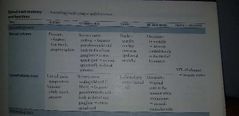
|
|
|
|
What are the 3 types of ischemic strokes? |
Thrombotic Embolic Hypoxic |
|
|
|
The hypoxic stroke is commonly during ? |
Cardiovascular surgeries and affect watershed areas |
|
|
|
Thrombotic strokes are common where? And why? |
In the MCA over a ruptured atherosclerotic plaque |
|
|
|
Treatment and image diagnosis of ischemic stroke? |
TPA if within 3 to 4.5 hours of onset and sure it's not hemorrhage via MRI or non contrast CT. Thrombectomy and medical therapy like aspirin and clopidrogrel |
|
|
|
What's a Transient ischemic attack? |
Brief, reversible episode of focal neurologic disfunction without acute infarction. (-) in the MRI almost all resolve in less than 15 minutes by themselves. |
|
|
|
Aging related impaired accommodation focusing on near objects needing reading glasses |
Presbyopia |
|
|
|
What happens in hyperopia and how it is the eye? |
Eye is too short and light is focused BEHIND the retina |
|
|
|
What happens in myopia and how it's the eye? |
Eye is too long and light is focused IN FRONT of the retina |
|
|
|
What's astigmatism? And where it is located the refractive power in this pathology? |
Abnormal curvature of the cornea and has multiple focal points in the retina |
|
|
|
Describe age related macular degeneration! |
2 types Dry 80%: Deposition of yellowish material (Drusen) in between Bruch membrane and retinal pigmented epithelium. Slow and gradual loss of vision Wet 10% -15%: rapid loss of vision due to bleeding 2dary to choroidal neovascularization. |
|
|
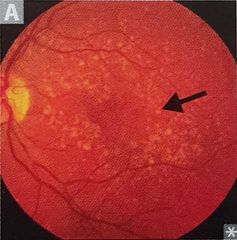
|
Age related macular degeneration |
|
|
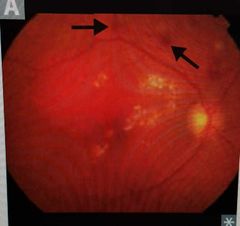
|
Diabetic retinopathy |
|
|
|
Describe diabetic retinopathy |
Two types Non proliferative: 95% damage capillaries leaks blood into the retina, lipids in the retina, hemorrhage and macular edema Proliferative: 5% Chronic hypoxia resulting in new blood vessels and retinal detachment |
|
|
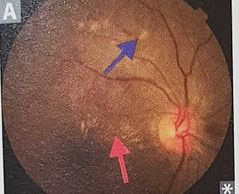
|
Hypertensive retinopathy |
|
|
|
Describe hypertensive retinopathy |
Retinal damage due to chronic uncontrolled Hypertension. |
|
|
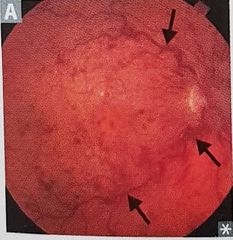
|
Retinal vein occlusion |
|
|
|
Describe retinal vein occlusion |
Blockage of veins due to compression of nearby arterial atherosclerosis. Retinal hemorrhage and venous engorgement. |
|
|
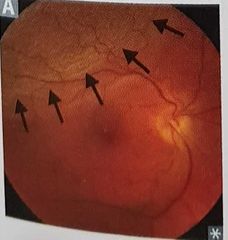
|
Retinal detachment |
|
|
|
Describe retinal detachment |
Separation of neurosensory layer of the retina (Rods and cones) from the outermost pigmented epithelium. Degeneration of photoreceptors leads to vision loss like a curtain drawn down . It's a surgical emergency. |
|
|
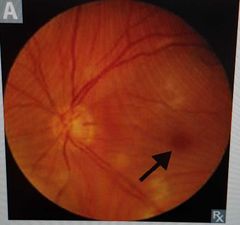
|
Central retinal artery occlusion |
|
|
|
Describe central retinal artery occlusion |
Acute painless monocular vision loss with cherry red spot on the fovea. Think of embolic source. |
|
|
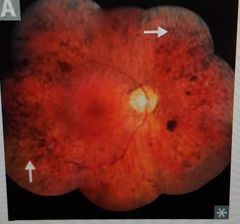
|
Retinitis pigmentosa |
|
|
|
Describe retinis pigmentosa |
Inherited progressive retinal degeneration. Night blindness with bone and spicule shaped deposits Loss of photoreceptors. Legally blind by the age of 40 Rods affected first |
|
|
|
Describe papilledena |
Optic disc swelling usually bilateral due to ♤ICP. Enlarge blindspot and elevated optic disc swelling with blurred margins |
|
|
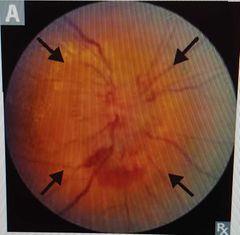
|
Papilledema |
|
|
|
Describe conjunctivitis and the types |
Inflammation of the conjunctiva-- red eye 3 types: •Allergic: itchy eyes, bilateral •Bacterial: pus, treat antibiotic •Viral: most common, often adenovirus, sparse mucous discharge, ♤lacrimation, self resolving |
|
|
|
Describe cataracts |
Painless opacification of the lens, often bilateral, resulting in glare and ♡vision loss especially at night. |
|
|
|
Risk factors for cataracts? |
Old age Alcohol abuse Diabetes mellitus Smoking Excessive sunlight Prolonged corticosteroids use Trauma Infections |
8 |
|
|
Congenital risk factors of cataracts? |
Galactosemia Galactokinase deficiency Trisomy 13,18,21 Torch infections Marfan syndrome Alport syndrome NF type 2 |
|
|
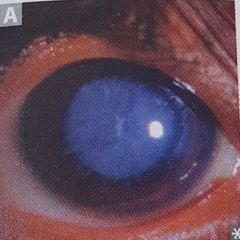
|
Cataracts |
|
|
|
Describe the Polyol Pathway of cataracts |
♤ in glucose leads to increase in sorbitol. Sorbitol converts to fructose but it's a slow process that leads to acumulation of sorbitol and eventually opacification of the lens. |
|
|
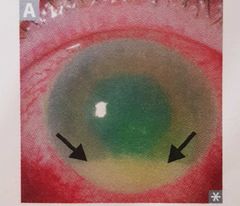
|
Uveitis with hypopyon |
|
|
|
Describe uveitis |
Inflammation of the uvea, name based on the location of the inflammation. Anterior uveitis : iritis Posterior uveitis: choroiditis or retinitis
|
|
|
|
What's hypopyon? And its associated with what? |
Accumulation of pus in anterior chamber of the eye. Associated with systemic inflammatory disorders like sarcoidosis, arthritis rheumatoid etc.... |
|
|
|
After how much time of ischemia theres irreversible damage in the brain? |
5 minutes |
|
|
|
Most vulnerable areas of the brain in case of ischemia and what's the pnemotecnic? |
Vulnerable hippos needs pure water Vulnerable Hippocanpus Neocortex Purkinje cells Watershed areas |
|
|
|
Whats the Pathophysiology of Myasthenia gravis? |
85% of cases involves autoantibodies directed against postsynaptic acetylcholine receptors (AchR), thereby impairing neuromuscular transmission. 10–15% of cases are associated with thymoma. |
|
|
|
Autoimmune neuromuscular disease characterized by generalized muscle weakness. Women are more frequently affected and about 10–15% of cases are associated with thymoma. The most common initial symptoms are ptosis and/or diplopia due to ocular muscle weakness, with the disease usually progressing to generalized weakness within two years. |
Myasthenia Gravis |
|
|
|
Clinical presentation of Myasthenia gravis? |
Muscle weakness worsens throughout the day with increased activity and improves after rest. |
|
|
|
Treatment of choice for Myasthenia gravis? |
Acetylcholinesterase inhibitors, possibly in combination with immunosuppressive drugs |
|
|
|
Chronic, degenerative disease of the CNS that is caused by an immune-mediated inflammatory process. This process results in the demyelination of white matter in the brain and spinal cord. |
Multiple Sclerosis |
|
|
|
What type of immune mediated inflammatory process is Multiple sclerosis? |
Type 4 |
|
|
|
What type of immune mediated inflammatory process is Myasthenia Gravis? |
Type 2 |
|
|
|
Investigation of choice for the diagnostic of MS? |
Brain and spine MRI with Multiple sclerotic plaques in periventricular areas |
|
|
|
What's a Migrane? |
headache characterized by recurrent episodes of unilateral, localized pain that are frequently accompanied by nausea, vomiting, and sensitivity to light and sound. |
|
|
|
Injury of the upper trunk of the brachial plexus (C5-C6) cause what type of palsy? |
Erb palsy |
|
|
|
Weakness of muscles in the C5 and C6 myotomes → flexed wrist with an extended forearm and internally rotated and adducted arm (waiter's tip posture)
|
Erb palsy
|
|
|
|
Injury to the lower trunk of the brachial plexus (C8–T1) cause a what palsy? |
Klumpke palsy
|
|
|
|
Weakness of muscles in the C8 and T1 myotomes (intrinsic hand muscles) → total claw hand
|
Klumpke palsy
|
|
|
|
Pelvic Ring fracture with sensory deficits on Medial thigh its an injury on what nerve? |
Obturator nerve injury
|
|
|
|
A lumbar disc herniation between the vertebral bodies L5 and S1 is a common cause of S1 radiculopathy, which can manifest with?
|
Weak achilles tendon reflex |
|
|
|
Diminished sensation of the anterior lateral thigh is consistent with an injury to wich Lumbar region? |
L3 Radiculopathy |
|
|
|
Difficulty walking on heels (e.g., foot drop) may be seen in patients with an injury to wich root nerves? |
L4 or L5 nerve roots
|
|
|
|
Which vitamin deficiency is commonly seen in association with isoniazid (INH) use in antituberculosis treatment? |
Pyridoxine (vitamin B6)
|
|
|
|
In a immunocompromised patient, multiple ring enhancing lesions within the subcortical white matter, basal ganglia, and/or thalamus are highly suggestive of
|
Cerebral toxoplasmosis |
|
|
|
Patients with inherited retinoblastoma gene (Rb gene) mutations and Leucokoria have a significantly increased risk of developing |
Osteosarcomas |
|
|
|
The earliest sites of neurodegeneration in Alzheimer disease are structures in the medial temporal lobe such as the ___________, __________,which are critical for memory formation.
|
hippocampus and parahippocampal cortex |
|
|
|
Orthostatic hypotension, livedo reticularis, peripheral edema, and ataxia are sings toxicity of what medication in a newly diagnosed parkinson patient? |
Amantadine Toxicity |
|
|
|
Mechanism of action of Amantadine? |
Amantadine increases dopamine release, decreases dopamine reuptake, and inhibits the N-methyl-D-aspartate (NMDA) receptor.
|
|
|
|
ATP-dependent motor protein responsible for the retrograde migration and movement of cellular organelles and proteins along microtubules in axons used by rabies virus to infect the CNS |
Dynein |
|
|
|
Wich is the mechanism of action of triptans, which are considered first-line abortive therapy for the treatment of acute migraine headaches and cluster headache attacks?
|
Activation of 5-HT1 receptors |
|
|
|
Is a common complication of axillary lymph node dissection, it present with winged scapula caused by paralysis of the serratus anterior muscle.
|
Long thoracic nerve injury |
|
|
|
is the most common parasitic disease of the nervous system and the most important cause of adult-onset seizures in Asia, Africa, Central and South America |
Neurocysticercosis by Taenia solium
|
|
|
|
Most common cause of anti-Yo antibody-associated PCD in women
|
Breast cancer
|
|
|
|
In Huntington Disease the mutation is on which chromosome? What neurotransmiser is increased and which is decreased? |
Chromosome 4 Increased Dopamine Levels Decreased Ach, and Gaba |
|

